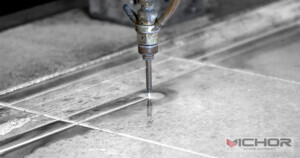
How Pressurized Water Cutting Metal Transforms Modern Manufacturing
Imagine a cutting tool so precise it can slice through intricate patterns in metal without generating heat, so versatile it can handle materials from soft rubber to hardened titanium, and so environmentally friendly that its primary ingredient is water. This is not a vision of the future; it is the reality of pressurized water cutting metal, a technology officially known as abrasive waterjet cutting. By harnessing the immense power of water accelerated to extreme velocities, this method has revolutionized fabrication, aerospace, automotive, and art industries. It offers a unique combination of cold-cutting capability, exceptional precision, and material versatility that traditional methods struggle to match. This article delves deep into the world of pressurized water cutting metal, explaining its mechanisms, advantages, and practical considerations.
The Core Principle: How Pressurized Water Cutting Metal Actually Works
At its heart, the process of pressurized water cutting metal is an elegant application of physics. It’s far more complex than simply spraying water at high pressure. The system begins with a high-pressure intensifier pump that pressurizes ordinary water to an astonishing 60,000 to 90,000 PSI (4,000 to 6,200 bar). This ultra-high-pressure water is then forced through a tiny orifice, typically made of sapphire or diamond, creating a supersonic stream.
For cutting hard materials like metal, an abrasive substance, such as garnet, is introduced into this stream. The water stream acts as an accelerator, entraining the abrasive particles in a mixing tube and focusing their kinetic energy onto a microscopic point on the workpiece. The actual cutting is performed by this abrasive slurry, which erodes the material along a programmed path. It is a process of precise, high-speed erosion rather than melting or tearing, which is why pressurized water cutting metal is classified as a cold-cutting process.
Why Choose Water? The Unmatched Advantages of Pressurized Water Cutting
The growing popularity of pressurized water cutting metal is due to a compelling set of advantages over laser, plasma, and mechanical cutting.
No Heat-Affected Zone (HAZ): This is arguably the most significant benefit. Since the process uses abrasion and not heat, it does not alter the metallurgical structure of the metal. There is no hardening, warping, or thermal stress, preserving the material’s original strength and properties.
Exceptional Versatility: A single pressurized water cutting machine can process a staggering range of materials. From aluminum and stainless steel to titanium, copper, brass, and even reflective materials like copper, which are challenging for lasers. It can also easily switch to cutting stone, glass, composites, and plastics without changing the fundamental setup.
High Precision and Edge Quality: The narrow stream, or “kerf,” allows for intricate shapes and sharp corners with minimal material waste. The resulting edge is typically smooth and requires little to no secondary finishing, saving both time and money.
Environmental and Safety Benefits: The process produces no hazardous fumes or vapors, as there is no combustion or melting. It is a cleaner and safer operation for operators. Furthermore, the used water and abrasive can often be collected and treated or recycled.
The Key Components of a Pressurized Water Cutting System
Understanding the technology requires a look at its essential components, each playing a critical role in achieving a clean cut.
High-Pressure Pump: The heart of the system. It generates the immense pressure required, typically using an intensifier or a direct-drive pump technology.
Abrasive Delivery System: This subsystem stores and meters the abrasive garnet, injecting it into the water jet at the correct flow rate for consistent cutting performance.
Cutting Head: This includes the orifice (which creates the pure water jet) and the mixing tube (or nozzle), where the abrasive is mixed with the water and focused into a coherent, powerful cutting stream.
CNC Motion System: A computer-controlled gantry or robot arm that moves the cutting head with extreme accuracy along the programmed cutting path, ensuring precision and repeatability.
Catcher Tank: Located beneath the workpiece, this tank safely contains the spent water and abrasive, dissipating the stream’s remaining energy and allowing for material collection and water management.
Ideal Applications: Where Pressurized Water Cutting Metal Shines
The unique capabilities of pressurized water cutting metal make it the preferred choice for numerous applications across diverse sectors.
Aerospace Industry: Used for cutting heat-sensitive materials like titanium and aluminum alloys, complex engine components, and advanced composites without compromising their structural integrity.
Automotive Sector: Ideal for prototyping, creating custom interior panels, cutting gaskets, and processing high-strength steel and aluminum body parts.
Architecture and Art: Allows artists and architects to create complex metal sculptures, decorative panels, and intricate inlays with a level of detail that is difficult to achieve with other methods.
Job Shops and General Fabrication: The ability to quickly switch between different materials and jobs without tooling changes makes it incredibly efficient for custom and low-to-medium volume production runs.
Limitations and Material Considerations
While incredibly versatile, pressurized water cutting metal is not a universal solution for every situation.
Cutting Speed on Very Hard Materials: While it can cut virtually any metal, the cutting speed for extremely thick or hard materials like tempered tool steel can be slower than that of plasma or flame cutting.
Initial Investment: The upfront cost of a high-quality pressurized water cutting system can be higher than some traditional thermal cutting machines.
Taper: A natural characteristic of the process is that the jet can create a slight taper, meaning the top of the cut is slightly wider than the bottom. Modern systems and advanced software can compensate for this to produce near-perpendicular edges.
Addressing Common Questions About Pressurized Water Cutting Metal
Prospective users often have specific questions before adopting this technology.
Q1: How thick of a metal can be cut with pressurized water?
A: Pressurized water cutting metal is capable of cutting metals over 12 inches (300 mm) thick. However, the cutting speed decreases significantly as thickness increases. For most industrial applications, cutting metals in the 1-inch to 6-inch range is where the technology offers an excellent balance of speed and quality.
Q2: Is the process truly safe to use, given the extreme pressure?
A: Modern systems are designed with multiple layers of safety, including pressure sensors, containment systems, and emergency stop functions. While the stream itself is extremely dangerous and requires strict safety protocols (like never placing hands near the cutting head), the enclosed nature of industrial machines makes the operational environment very safe for trained personnel.
Q3: What is the “mist” generated during the process, and is it harmful?
A: The mist is a fine aerosol of water and very fine abrasive particles. While not toxic, inhaling any particulate matter is not advisable. Therefore, operating a pressurized water cutting system within a well-ventilated area or using an optional mist collector is a standard and recommended practice.
Q4: Why is garnet the most common abrasive used?
A: Garnet is a hard, sharp, and relatively inexpensive mineral. It provides the perfect balance of cutting efficiency and cost. It fractures in a predictable way, maintaining its cutting ability throughout the process. Other abrasives exist but are less common due to higher cost or specialized applications.
Q5: How does the operating cost of pressurized water cutting compare to laser?
A: The cost structure is different. Pressurized water cutting has no cost for gases like oxygen or nitrogen (as with lasers) but has ongoing costs for abrasives, water treatment, and orifice/mixing tube wear parts. For materials that are reflective or sensitive to heat, the waterjet often has a lower total cost because it eliminates the need for post-processing to remove heat damage.
Pressurized water cutting metal has firmly established itself as an indispensable technology in the modern manufacturing landscape. Its ability to perform cold, precise cuts on an unparalleled range of materials, all while maintaining an environmentally friendly profile, sets it apart. As the technology continues to advance with improvements in pump efficiency, cutting speed, and automation integration, its adoption is poised to grow even further. For any industry seeking a versatile, precise, and heat-free method for shaping metal, investing in pressurized water cutting technology is a clear step toward a more efficient and capable future.
continue reading
Related Posts
- 1371 words6.9 min read
- 1449 words7.3 min read


